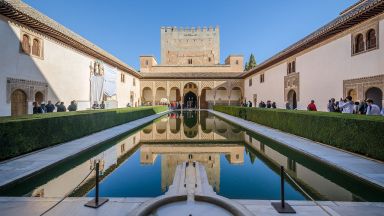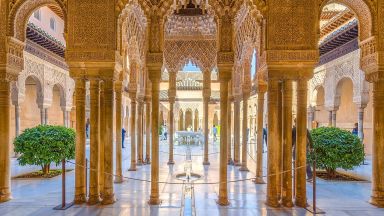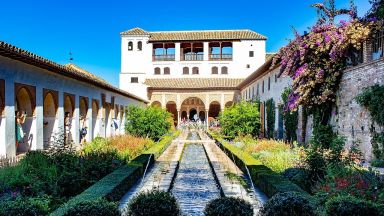Albaycin
Area in Granada

Albaycin is a neighborhood and district of the old Moorish quarter in the city of Granada. The neighborhood has neat narrow lanes and well-kept traditional houses, the area has retained its old charm and is the ideal place to discover Moorish architecture. Albaicín is especially famous for its dramatic views overlooking the Alhambra palace. This old neighborhood on the Granadan hill delimited by Calle Elvira and the Darro river was declared World Heritage Site by the UNESCO in 1993.
Where in Granada is the Albaicín Located?
The Albaycin is the old Arab Quarter. It comprises approximately the area between the hill of the Alhambra, the hill of San Cristobal, the Sacromonte and Elvira.
History of the Albaicín in under a Minute
It was the place where the first Siri court was built in the eleventh century. The Zirid Monarchs first established their court here in the 11th century although little remains from this era today, apart from some crumbling remains of the wall (including the section which used to encircle the Albaicín and the gates of El Arco de las Pesas, Monaita and Elvira).
At the height of splendor the Albaycin enjoyed in the last years of Nazarid dominance, the quarter comprised a population of more than forty thousand inhabitants and thirty mosques.
The history of the Albayzín is strictly related to the Moors’ in the city of Granada. It was after the fall of Cordoba, in 1236, that the center of Moorish power was transferred to Granada – bringing a massive influx of nobles, architects and money which led to the construction of a fabulous new castle on the hill across the river valley: the Alhambra, Calat-Al-Hama or “The Red Castle”, so called for its reddish stone. During this period, some 40.000 inhabitants lived here, and roughly 30 mosques were erected. Most of what we now call Albaicin was in fact the Alcazaba, the Moorish citadel, stretching from the Colegiata del Salvador to the Plaza San Miguel Bajo. Only the western wall of this fortress still exists (it’s best seen from the Mirador San Cristobal); the castle keep stood on what is now the Plaza San Nicolás.
In 1568, when the Catholic Monarchs re-conquered Granada, the Moorish population that wanted to remain in Granada settled here. But soon the population dwindled and eventually the constant revolts forced the monarchs to expel the Arabs who were still practicing Muslims. The mosques were demolished and on the same sites churches were raised. Although most of the Albaicin’s churches are built on the foundations of Moorish mosques, and many have conserved their external cisterns for the ritual washing of the faithful, little remains intact from the 8 centuries of Moorish occupation, apart from the great city gates (Elvira, Monaita, de las Pesas and half of Bab-Al-Bonud), the western walls, several interesting minarets-converted-into-bell-towers (the most precious of which is the Alminar de San José) and the courtyard of what was once the Albaicin’s Great Mosque, now attached to the church of the Colegiata del Salvador.
Likewise, the Christians converted the Moorish houses into beautiful gardens. This is one of the reasons why the neighbourhood faced a period of decline.
Where does the Albaicin get its name?
Some say that the name Albaicin means “quarter of the falconers”, but most historians prefer “quarter of the people of Baeza”. When the Moors were driven by the Christians out of the city of Baeza, near Jaen, in the 13th century, they fled to Granada and re-settled on the northern part of the hill, creating a suburb which took on the name of their former home.
How to reach the Albaicin
You can reach the Albayzin by taking bus number C31, C32 and C34. The last bus to the Albaycin departure from Plaza Nueva at about 23:00 from Sunday to Thursday, and on Friday and Saturday at 01:00 at night. Last departure from Albaycin to Plaza Nueva from Sunday to Thursday at 23:30, and on Friday and Saturday at 01:30 at night.
What to See in the Albaicin Neighborhood of Granada
Thanks to a century-year-old history, the Albayzín is populated with countless monuments on which you can’t miss out. For example, the church of Santa Ana, with a minaret in its bell tower; the 16th-century Colegiata del Salvador, on the rest of the Albayzín’s main mosque; or the Mezquita Mayor de Granada, opened in 2003 to serve the current Muslim population of Granada.
Likewise, don’t miss out on the Archaeological Museum, displaying Granada’s past through astrolabes and old tools. It is located in an ancient Renaissance mansion.
The Albaycin appears in our Complete Guide to Visiting Granada!
This website uses affiliate links which may earn a commission at no additional cost to you!
Visiting Albaycin
Nearby Attractions
- Plaza Larga (0.1) km
Market and Square in Granada - Mirador de San Nicolás (0.1) km
Viewing Point in Granada - Church Of San Salvador (0.2) km
Church in Granada - Palacio de Dar-Al-Horra (0.2) km
Palace in Granada - Arab Baths of Granada (0.4) km
Baths in Granada - Puerta de los Tablero (0.4) km
Bridge, City Gate and City Walls in Granada - Paseo de los Tristes and Casa de las Chirimías (0.5) km
Park in Granada - Puerta de las Armas (0.5) km
City Gate in Granada - Torre de las Armas (0.5) km
Tower in Granada - Torre del Cubo (0.5) km
Tower in Granada


